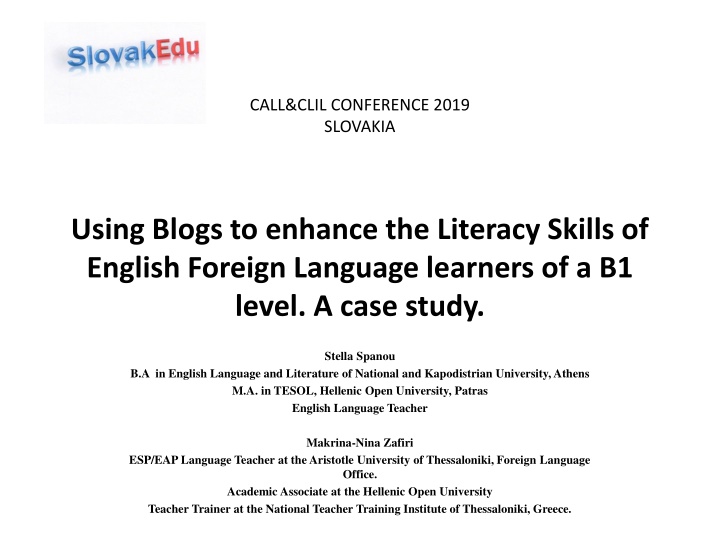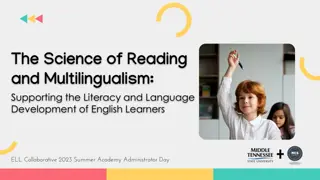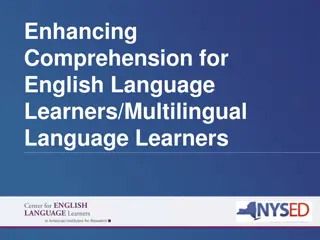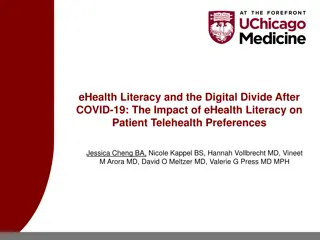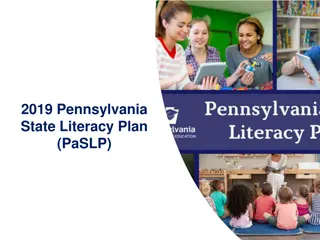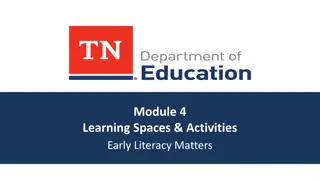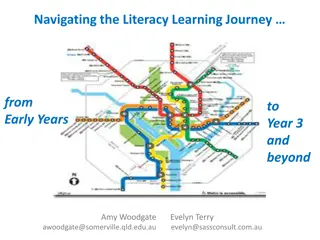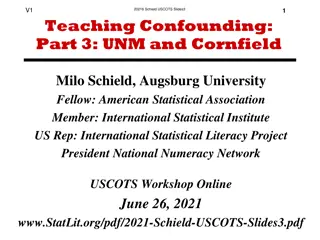Enhancing Literacy Skills of B1 English Learners through Blogs: A Case Study
Research conducted in Athens, Greece, focused on utilizing blogs to improve writing and reading skills of B1 level English learners. The study compared traditional teaching methods with a differentiated approach, incorporating Computer Assisted Language Learning (CALL). The use of blogs aimed to enhance collaborative learning and social interaction among students, resulting in improved literacy skills. The project aligns with the Common European Framework of Reference for language teaching.
Download Presentation

Please find below an Image/Link to download the presentation.
The content on the website is provided AS IS for your information and personal use only. It may not be sold, licensed, or shared on other websites without obtaining consent from the author.If you encounter any issues during the download, it is possible that the publisher has removed the file from their server.
You are allowed to download the files provided on this website for personal or commercial use, subject to the condition that they are used lawfully. All files are the property of their respective owners.
The content on the website is provided AS IS for your information and personal use only. It may not be sold, licensed, or shared on other websites without obtaining consent from the author.
E N D
Presentation Transcript
CALL&CLIL CONFERENCE 2019 SLOVAKIA Using Blogs to enhance the Literacy Skills of English Foreign Language learners of a B1 level. A case study. Stella Spanou B.A in English Language and Literature of National and Kapodistrian University, Athens M.A. in TESOL, Hellenic Open University, Patras English Language Teacher Makrina-Nina Zafiri ESP/EAP Language Teacher at the Aristotle University of Thessaloniki, Foreign Language Office. Academic Associate at the Hellenic Open University Teacher Trainer at the National Teacher Training Institute of Thessaloniki, Greece.
Abstract This research focused on the development of the writing and reading skills of B1 level learners of English in a private language institute in Athens, Greece, with the aid of blogs (a web tool), as Computer Assisted Language Learning (CALL) is known to enhance foreign language learning. To this end, two groups of young learners were formed; the control group which was taught through the traditional coursebook and the experimental group which was taught through a differentiated approach to language teaching. The differentiated instruction which was applied involved eight teaching sessions in the private language institute. Pre-tests and post-test were administered to both groups in order to evaluate the use of CALL in the improvement of their literacy skills. Pre- and post- semi-structured interviews were also conducted with the students of the experimental group to evaluate their attitudes and feelings before and after the instruction. The aim of using blogs, as a web tool, was to enhance collaborative learning and social interaction, thus a blogosphere was created. For the purposes of this research, students were involved in process writing, by making drafts and by writing their posts. They were also involved in active reading when they read other posts and texts from other web sites.
THEORETICAL BACKGROUND OF THE RESEARCH 1. Theoretical Background of the Common European Framework of Reference (CEFR) in a Foreign Language Institute Schoolchildren in Greece learn English as a foreign language both in the public sector schools and in private language institutes (in the private sector). These institutes abide to the CEFR which provides a framework for teaching curricula, textbook design and assessment of each level. The aim of the CEFR is to establish mutual communication between the citizens of its member-states, thus establishing communicative and learning goals. These goals are in the form of can-do statements in each level of the teaching/learning process (Council of Europe, 2018).
1.1. The CEFR and B1 level young learners Young Learners are learners between 6 to 12 years of age. Since language is a priority, there emerged the need to improve mastery skills from an early age, thus designing language descriptors for young learners (Nikolov, 2016). Global scale descriptors: summarize the skills of each level. Descriptors dealing with reception skills: concern listening and reading. Descriptors dealing with production skills: concern speaking and writing.
1.2. The CEFR and Writing Skills Global Scale Criteria on Writing Skills: independent user (B1 level) is someone who can produce a simple connected text on topics which are familiar or of personal interest and can describe experiences, events, hopes, dreams, ambitions and briefly give reasons and explanations for opinions and plans (Council of Europe, 2001, p.5 ). Writing as a production activity: grammatical correctness and correct use of vocabulary (Fasoglio, Beeker and Keuning, 2014). Students develop production strategies such as: compensating, planning and monitoring. Writing as an interaction activity: students describe personal feelings/opinions, they write simple and relevant pieces of information to friends and they use appropriate phrases to maintain a discussion with another speaker (turn taking).
1.3. The CEFR and Reading Skills Reading as a receptive skill: a B1 level user can read factual information on texts concerning his/her interests with a satisfactory amount of comprehension. Reading Purposes: read for information, read for leisure, read to understand a description. Reading Strategies (Newby, 2012): making inferences from the text, predicting the topic of the text from its title and/or illustration(s), following the sequence of events, amplifying a text. 1. 2. 3. 4.
1.4. The CEFR and Computer Mediated Communication (CMC) CEFR Criteria concerning the CMC and B1 level users (Council of Europe, 2018): B1 users can post their contribution online on a familiar topic if they have prepared the text beforehand and they can use online tools (such as online dictionaries/grammars) to check their language accuracy. They can post information about personal experiences and feelings and respond to others comments. However, some lexical errors may occur. Visuals (e.g. animation, images, videos) increase online collaboration (Hathorn and Ingram, 2002). Online collaboration increases motivation (Hathorn and Ingram, 2002). Use of technology and online collaboration Learners construct their own learning by negotiating and discussing with peers (Farr and Murray, 2016). 1. 2. 3. 4. 5.
2. Literacy Skills 2.1. Developing Writing Skills Text-oriented approach: writers express their view following grammatical rules (Jones, 2006) (structuralism, form, product, accuracy). Writer-oriented approach: focus on the writer, on the cognitive processes and on the free expression of ideas (Hyland, 2002). Reader-oriented approach: focus on the language as a vehicle of communication between reader-writer (Hyland, 2002).
2.2. Developing Reading Skills 1. Pre-reading stage: activation of background knowledge and cognitive schemata inferencing brainstorming pre-teaching vocabulary pre-reading questions use of visuals.
2. While-stage: skimming scanning write each paragraph s main idea read and complete sentences (Vrublevskis, 2015). 3. Post-stage: write a summary role-play fill in charts and tables be involved in class discussion (Ibrakhimova, 2016).
3. Differentiated Instruction the teacher prepares his/her teaching in a variety of ways to address students different needs and to make adjustments. There is no single approach. It is a student-centered approach, bearing in mind that not all students have the same needs, sociocultural and linguistic background, interests and abilities. Teachers can make adjustments during the instruction process and assessment occurs throughout the lesson, not at the end of it, simply for the reason of measuring the instructional process (Hall, 2002). It creates a sense of community; not only do students work individually but they also work in pairs or as a whole class.
Differentiating through process. Differentiating through product. Differentiating through content. Differentiating through the environment.
4. The use of BLOGS in ELT 1. Blogs: an online journal that users can continuously update by writing posts. It is the first widely adopted tool of the Read/Write Web (Richardson, 2010). there is a basic word doc. to use, to write your post(s) and to respond. Users can also add pictures, hyperlinks, audio files or videos (Yang, 2009). the language used is typed and written but it has many similarities to informal and spoken language (hybrid language talking in writing)
2. Blogs in ELT: a blog is a web-based technology which supports collaboration and increases students performance (Yang, 2009). there is blended learning; both online and traditional approaches can be used in the teaching/learning process (Paroussi, 2014). they create a sense of community; students can share their opinion, ask questions and collaborate with peers. students can control their own learning by working at their pace, searching on the internet and collecting information, taking initiatives with no teacher s intervention and using pictures, audio/video files and hyperlinks (Vlachos, 2009). self-publishing online encourages ownership and increases learner independence (Kennedy, 2003).
Students learn how to participate in online discussions, assess other sources of information, such as online dictionaries, and evaluate the information they gather (Warschauer, 2000). they can become high-achievers by using a range of tools and resources, such as selecting pictures and art work, creating graphics, downloading and posting photos, copying and pasting hyperlinks and finally, posting audio files or videos (Bell, 2010).
3. Blogs and Writing Skills Students write posts to address to a wider audience outside the classroom, that is, a global community (Paroussi, 2014). When they are involved in writing, they experiment with language by planning, drafting, redrafting and evaluating their written texts before finally editing and posting their process writing. It is directed to a genuine audience. It has authentic content. Peer feedback is received. There is less social anxiety.
4. Blogs and Reading Skills Students are willing to read extensively because the internet becomes a tool for them which connects them with the outside world (Vlachos, 2009). The writer needs to read first, so that s/he can become familiar with the topic, and so that s/he skims through many posts. the posts are archived in reverse chronological order with a title and a main body (Duffy and Bruns, 2006). they can use hyperlinks which connect them to other web pages, images and the multimedia, such as videos or audio files. by reading a variety of posts in a blog, readers develop critical thinking and they create a blogosphere; bloggers interact with each other with their views and ideas.
5. The design of blogs in the current teaching situation Students topics were based on the syllabus of the coursebook, such as the environment, health, entertainment and teen stress. Each blog had a main title and there was a title in each task. The arrangement of the tasks was in reverse chronological order, starting from the bottom of the page moving upwards. The archived information was also shown with a date on which the entry was made. The add comment button was allotted to the user of the blog to contribute to his/her post by making a comment, thus giving feedback both to the teacher and his/her classmates (Blackstone and Wilkinson, 2010). There were different plug-ins, such as videos, pictures and hyperlinks.
5. Research Methodology 1. Aim of the research the aim of the research is to examine whether blogs can improve reading and writing skills of students in an online community and whether it enables them to promote collaborative learning. by using technology in the classroom, the teacher will modify the curriculum to adapt learners different needs and interests and develop language skills (Tomlinson, 2014).
2. Research Questions This research attempted to answer the following research questions: Does the CEFR encourage the use of online communication with the use of blogs? How can blogs enhance young learners writing skills? How can blogs enhance young learners reading skills? Does the teaching context in foreign language institutes encourage the use of CMC in English language learning? Can blogs develop a positive attitude towards reading? Can blogs develop a positive attitude towards writing?
3. Methodology Action Research: the researchers are also the teachers. selecting the focus ( the development of reading and writing skills through the use of technology). identifying the research questions which would enable the researchers to guide their quest. collecting and organizing data through the two groups, namely the control group and the experimental group. pre- and post- reading and writing tests which were taken by both groups (Sagor, 2000). pre- and post- semi structured interviews were also conducted with the experimental group to identify their attitudes and feelings. recordings of the lessons and notes which were kept in the teacher s journal. the analysis of data included the comparison of the post-test results between the control group and the experimental group to check if the approach which was applied brought the desirable effects. (Brooks, undated). taking informed action; the researchers needed to take specific steps to avoid students past mistakes, such as applying alternative teaching methods, approaches and techniques.
Data Collection Instruments 1. Semi-structured Interviews the researchers have direct access to the students attitudes, feelings and perceptions. students answer their questions based on their real-life experiences (Piercy, undated). semi-structured interviews include both closed-response (yes/no) and open-response questions. However, open-response questions are more preferable in that they can provide more personal responses, thus richer information (McNiff and Whitehead, 2006). there is face-to face interaction. the students can ask for clarifications. some questions can be omitted or modified.
2. Pre- and Post- Tests Pre- and post- tests compare what the students know at the beginning of the instruction to what they will have achieved after the class experience. The same pre- test was given to both groups focusing on reading and writing skills to examine pre-existing knowledge on these skills. After the experimental instruction, the same post-test was given to both groups in order to measure their learning outcomes as a result of a course experience in the experimental group and if, the results of the experimental group differ to that of the control group. The pre-test : as a diagnostic test checks specific strengths and weaknesses. The post-test : as a summative test, at the end of the programme, is applied as a means to measure achievement or specific outcomes (Cohen, Manion and Morrison, 2007).
3. Qualitative Research: the teacher is involved in inquiry and problem-solving practices (Hulett, 2007), the teacher is an observant, the settings are natural; students have lessons in a real context (classroom) and they are the real participants working in small groups, students are interviewed before and after the instruction. 4. Class Observation the feature of observation enables the researcher or the researchers to collect live data giving authenticity to the research (Cohen, Manion and Morrison, 2007). observation can be done to the physical setting (classroom or computer lab, seat arrangements, how many computers are used), the human setting ( participants, gender, age), the interactional setting (formal/informal interactions, verbal or non-verbal, paralinguistic features) and the programme setting (resources, tools, curriculum).
6. Results 1. Results of the Pre-Semi Structured Interviews most of the students wanted to be interviewed in Greek rather than English, the majority of the students consider reading as the easiest skill and writing as the most difficult, although students are aware of using computers, they do not know what a blog is and what it is used for, three out of four students believe that they are good or very good at reading and only two out of four think they are very good at writing (Figure 1), reading is considered to be the most likeable and easiest skill whereas writing is thought to be the most difficult requiring more effort and time (Melissourgou and Frantzi, 2015), all of the students use the internet and a computer to search for information for their schoolwork, watch videos and listen to music but only 50% of them use English when browsing the net (Figure 2).
Figure 2-students own assessment on reading and writing 4 assess your performance in reading 3 2 assess your performance in writing 1 0 weak good very good excellent
Figure 3-students and the use of computer/internet 4 3.5 3 2.5 2 1.5 1 0.5 0 play computer games search info for schoolwork watch videos on YouTube listen to music chat online with friends/relatives
2. Results of the Pre-Test a) The Experimental Group the three female students (Student 1, Student 2 and Student 3) received higher grades compared to the male student (Student 4). They scored 97%, 89% and 88% respectively, whereas the male student scored 77% (Table 1). 120 100 80 PRE-TEST TOTAL SCORE 60 40 20 0 STUDENT 1 STUDENT 2 STUDENT 3 STUDENT 4
In the writing part (from 0: fail to 5: excellent), the scores were 3/5, 4/5, 1/5 and 0/5 respectively (Table 2). WRITING SCORES 4.5 4 3.5 3 2.5 2 1.5 1 0.5 0 STUDENT 1 STUDENT 2 STUDENT 3 STUDENT 4
b) The Control Group Student 1 scored 96%, students 2 and 3 scored 92% and student 4 scored 76% (Table 3). 120 100 80 60 PRE-TEST SCORES 40 20 0 STUDENT 1 STUDENT 2 STUDENT 3 STUDENT 4
In the writing part, from 0 (very poor/fail) to 5 (excellent), Students 1 and 2 scored 3 out of 5, Student 3 scored 2 out of 5 and Student 4 scored 1 out of 5 (Table 4). 3.5 3 2.5 2 WRITING SCORES 1.5 1 0.5 0 STUDENT 1 STUDENT 2 STUDENT 3 STUDENT 4
3. Results of the Post-Semi Structured Interviews A) About using computers in the EFL classroom a) b) c) d) All students liked using computers and blogs because: it was different than using books it had an interesting content some of them had never used blogs before they worked in pairs The majority of students liked blogs because they expressed their opinions and they contributed to their own piece of writing. They felt a bit anxious when writing in a blog because they had never used it before. However, they also felt creative and more independent than traditional lessons. Blog lessons were considered as funny, creative and motivating to use English and the computer outside the class, as well.
B) About using blogs and literacy skills Writing in a blog was: a) easy, b) there is no fear of marking, c) personal expression of opinion, d) using the computer is motivating, e) improvements in using grammar and syntax correctly are evident. f) however: students in research - felt they needed more practice. Pairwork= helpful to use grammar, spelling and vocabulary correctly Reading in a blog is helpful to: a) understand the text by its title and pictures b) scan the text for specific information c) understand the text s gist even if there are unknown words
C) About e-literacies and using blogs 1. 2. 3. 4. 5. Students could: use the WORD better, copy and paste information from the internet more easily, predict the content of the blog by its title, improve their spelling by using the keyboard, browse the internet to find information easier. Students were willing to use computers and English outside the classroom for schoolwork and projects.
4. Results of the Post-Tests a) Experimental group the same pre-test was also administered as a post-test, 50% of the students in the experimental group achieved higher grades than in the pre-test, 98% and 90% respectively (instead of 97% and 89% in the post test) (Table 11), the other 50% of the students scored a little lower than in the pre-test (85% and 76% instead of 88% and 77% in the pre-test), students who scored lower grades expressed cognitive fatigue because of the written form of the assessment (Sievertsen and Piovesan, 2015), concerning the writing part, Student 1 scored 4 out of 5, Student 2 scored 3 out of 5, Student 3 scored 4 out of 5 and Student 4 had a score of 2 out of 5. All four students of the experimental group showed a slight improvement in the writing section (Table 11).
Table 11- pre-test and post-test performance of experimental group STUDENT GENDER PRE-TEST PRE-TEST POST-TEST POST-TEST SCORE WRITING SCORE WRITING S1 female 97% 3/5 98% 4/5 S2 female 89% 3/5 90% 3/5 S3 female 88% 2/5 85% 3/5 S4 male 77% 1/5 76% 2/5
b) Control group The students of the control group achieved almost the same grades as in the pre-test(97%, 90% , 93% and 70%, namely as with the pre-test: 96%, 92%, 92% and 76%). The student with the cochlear implant found a difficulty in scanning for specific words from the text and substitute a word with a synonym and she also did not like these tasks. Task aversion is a factor in lower test grades (Ackerman and Kanfer, 2009). Regarding the writing part, Students 1 and 2 scored 4 out of 5, Student 3 scored 3 out of 5 and Student 4 scored 1 out of 5 (Table12)
Table 12pre-test and post-test performance of control group STUDENT GENDER PRE-TEST PRE-TEST POST-TEST POST-TEST SCORE WRITING SCORE WRITING S 1 female 96% 3/5 97% 4/5 S 2 male 92% 3/5 90% 4/5 S 3 female 92% 2/5 93% 3/5 S 4 female 76% 1/5 70% 1/5
7. Discussion of Results The mean score of the pre-test in the experimental group was 87% whereas the mean score of the post-test was 87,2%. All students in the experimental group performed better in the writing part of the post-test. All students liked using blogs in our lessons and they were motivated to write and read in English because it was something new for them and they could express their personal view. Pairwork , writing without receiving a grade and reading others posts before writing theirs were great incentives to deal with blogs. They could use grammar (i.e. the use of tenses) and vocabulary (i.e. choosing the correct word) better. They were motivated to use the computer and English more outside the classroom.
8. Limitations of the Research The differentiated instruction was initially 4 hours per week but it was reduced to 2 hours per week because of an arrangement in the schedule by the administration. We could not use the language lab because of noise constraints. There were only two computers in the class so we either worked in pairs or one at a time, thus spending more time. There was also parental pressure to cover the syllabus proposed by the foreign language institute, thus we could not spend more time on using blogs in the class. Students needed two lessons instead of one to become used to using technology (blogs) in the classroom.
9. Proposals for further research the use of technology (CMC) should be incorporated in the EFL classroom since it increases students motivation. future studies should be conducted including more students as participants (even more classes in the same or different language school). future studies should be helped if suitable equipment is provided (e.g. a computer for each student). future studies in the specific domain - would also be helpful if there is no parental or administrative pressure concerning the syllabus and the exams to obtain a certificate in English.
10. Concluding Remarks Students were excited to use computers and the internet in the class. Some students said that they were able to learn how to write in English and they were motivated to do so. All of the students in the experimental group had never seen a blog before. They helped each other in pair work. They were not bored as they were when using the traditional textbook. The asked the teachers/researchers for help only when they had trouble with the computer itself. It is very important that more time should have been given to develop the blog lesson. Administrative issues, parental pressure, change of timetable and lack of equipment were the major problems. Nevertheless, all students wanted to continue using both the English language and the computer outside the classroom. Differentiated instruction proved to be motivating and enjoyable, addressing to students needs and learning styles.
11. Bibliography Blackstone, B., Wilkinson, M. (2010). Blogging for Pedagogical Purposes . Transforming Literacies and Language, (pp.185-206). Farr, F., Murray, L. (2016). The Routledge Handbook of Language Teaching and Technology. UK: Routledge. Fasoglio, D., Bekker, A., Keuning, J. (2014). CEFR-level writing skills for English, German and French. The Netherlands: Netherlands Institute for Curriculum Development. Fessakis, G., Tatsis, K., Dimitracopoulou, A. (2008). Supporting Learning- by-Design Activities using Group Blogs . Educational Technology and Society, 11/4: 199-212. Hathorn, L., Ingram, A. (2002). Engagement in Online Learning Communities . Journal of Educational Computing Research, 26/3: 325-347.
Newby, D. (2012). Insights into the European Portfolio for Student Teachers of Languages.Cambridge: Cambridge Scholars Publishing. Nikolov, M. (2016). Assessing Young Learners of English: Global and Local Perspectives . Educational Linguistics, 25: 43-64. Vrublevskis, V. (2015). How to Teach Reading to the Net Generation Children. Hamburg: Anchor Academic Publishing.
